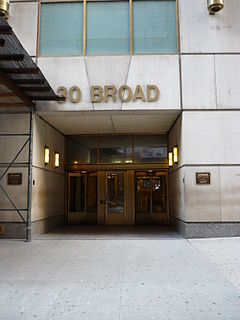Continental Bank Building
| Continental Bank Building | |
|---|---|

Continental Bank Building at 30 Broad Street
|
|
| General information | |
| Type | Banking, Brokering |
| Architectural style | art deco |
| Address | 30 Broad Street |
| Town or city | New York, New York |
| Country | United States |
| Coordinates | 40°42′21.99″N 74°0′41.56″W / 40.7061083°N 74.0115444°WCoordinates: 40°42′21.99″N 74°0′41.56″W / 40.7061083°N 74.0115444°W |
| Construction started | 1931 |
| Opened | 27 August 1932 |
| Cost | $20 million |
| Height | 564 feet (172 m) |
| Technical details | |
| Floor count | 48 |
| Floor area | 300,000 square feet (28,000 m2) |
| Design and construction | |
| Architect | Morris, O’Connor |
| Architecture firm | Cross and Cross |
The Continental Bank Building is a skyscraper located at 30 Broad Street in New York City that was completed in 1932. It is next to the .
In 1929, a new 50-story building was announced at 30 Broad Street (location of the former 15-story Johnston Building) to house the Continental Bank and Trust Company and various brokers. The site extends along Broad Street at 87 feet 7 inches (26.70 m), the length of Exchange Place runs 149 feet 8.5 inches (45.631 m) from New Street, and runs 88 feet (27 m) along New Street. The building site was once owned by the Dutch Reformed Church which had erected the city’s second almshouse on the site before 1659. Broad Street was originally a canal first known as “Common Ditch” then later “The Prince’s Ditch”.
The canal was filled in 1676, and it was first paved in 1693. The estimated cost of the new building is $20 million. The project is the largest single cooperative building venture undertaken to this time. Cross and Cross architects are announced as the building’s planners. An “unusual” feature of the building is a sub-basement clearing house where owner-tenants each have floor space and can transact business with other owner-tenants in the building by a system of pneumatic tubes to exchange receipts.
Architects Morris and O’Connor completed drawings in 1931 indicating 48 stories, 564 feet (172 m) above street level with a “simple” architecture. According to the architects, the structure is designed to express straightforward business of the highest class without excessive ornamentation. The first three stories of the façade are clad in limestone with the remainder made up of light-colored brick and dark brick at the spandrels. The building footprint rises from street level to floor 20 where the first setback is made until floor 23 where another setback is located.
The building tower then rises from floor 24 to floor 48. The top of the building is flat (having no ornament). The building’s lobby runs through from Broad Street to New Street with two elevator banks which serve the building, one set from the lobby to floor 20 and the other from the lobby to floors 21 through 47. The 48th floor is accessed by stairs from floor 47. Total rentable space is announced as 300,000 square feet (28,000 m2).
...
Wikipedia
